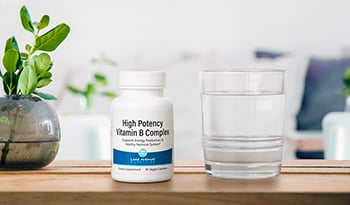The Top 3 Vitamin and Mineral Deficiencies in the World
DISCLAIMER:This blog does not intend to provide diagnosis...
- In this article:
- Defining Deficiency and Recommended Dietary Intake
- What Vitamins and Minerals Do in the Human Body
- Vitamin A Deficiency
- Vitamin D Deficiency
- Iron Deficiency
- The Bottom Line

One of the biggest nutritional myths is that diet alone can provide sufficient levels of all essential nutrients. It is a fallacy in underdeveloped and developed countries, including the United States. While conceivably possible, the reality is that most people do not come even close to nutritional adequacy without dietary supplementation. There is plenty of data to support this statement.
The World Health Organization indicates over 2 billion people suffer from a dietary deficiency of vitamins and minerals. And in the US, data from the National Health and Nutrition Examination Survey (NHANES) and the United States Department of Agriculture's Food Consumption and Nutrient Intakes for Americans show nutrient deficiencies exist in a substantial portion of the US population, perhaps as high as 80% for some vitamins and minerals.
Common deficiencies include potassium, zinc, magnesium, vitamin B6, folate, vitamin B12, iodine, and vitamin K2. But the most common vitamin and mineral deficiencies worldwide are vitamins A and D3 and iron.
Defining Deficiency and Recommended Dietary Intake
The level of an individual vitamin and mineral intake can range from severe deficiency to toxicity. Somewhere in between is the ideal intake level. Two related terms are widely used to set a standard for the desired intake: Recommended Dietary Allowance (RDA) and Recommended Dietary Intake (RDI).
- RDAs provide the daily dietary intake level of a nutrient considered sufficient to meet the requirements of 97.5% of healthy individuals based on their life stage (age), gender, and gender.
- RDIs were developed for food-labeling purposes and are numerically identical to the highest RDA value for any group.
One of the biggest criticisms of the RDA is that it is not based upon defining the optimal level of nutrient intake but rather the level of nutrient intake that will not result in any signs of deficiency and an estimate of the level of the physiological need for the nutrient in "healthy" people.
Between the level of deficiency and an adequate or optimal level is an area referred to as subclinical or marginal deficiency or nutrient insufficiency. These terms signify a level of nutrient intake above causing classic deficiency signs and symptoms but is less than optimal because it is associated with some evidence of physiological inadequacy. In many instances, the only clues of a subclinical nutrient deficiency may be fatigue, lethargy, difficulty concentrating, or a lack of well-being. Worse is that chronic, long-term subclinical deficiency may wear down our health over time.
What Vitamins and Minerals Do in the Human Body
Vitamins and minerals are essential nutrients, meaning the body cannot function correctly without them. One of the main functions of vitamins and minerals is that they are found in the active part of the enzymes, and coenzymes work together to build or break down molecules.
Most enzymes and coenzymes are composed of a protein and a co-factor, typically an essential mineral and/or a vitamin. If an enzyme lacks the essential mineral or vitamin, it becomes inactive. For example, zinc is necessary for the enzyme that activates vitamin A in the visual process. A diet with sufficient vitamin A becomes irrelevant if no zinc is available for use in the enzyme.
Most enzymes contain a protein and a co-factor, typically an essential mineral or vitamin. If an enzyme lacks the essential mineral or vitamin, it cannot function properly. The enzyme can perform its vital function by providing the necessary mineral/vitamin through diet or a nutritional formula. For example, zinc is required for the enzyme that activates vitamin A in the visual process. A diet with sufficient vitamin A is irrelevant because vitamin A cannot convert to the active form without zinc in the enzyme.
Many enzymes also require additional support to perform their function. The support is in the form of a coenzyme, a molecule that functions along with the enzyme. Coenzymes are often composed of a vitamin or mineral. Without the coenzyme, the enzyme is powerless.
In the body, micronutrients (vitamins and minerals) function interactively. A deficiency of any single vitamin or mineral disrupts this complex system and must be avoided to achieve and maintain health.
Vitamin A Deficiency
Vitamin A was the first fat-soluble vitamin discovered, but that is not the only reason it was called "A." It was named to signify its "anti-infective" properties. Vitamin A is critical to the health and function of the immune system. Vitamin A deficient individuals are more susceptible to infectious diseases, in general, but especially viral infections. In chronic vitamin A deficiency, the mucous membranes that line the respiratory tract, gastrointestinal tract, and genitourinary tract are also affected. It also severely affects the eyes.
In the eyes, vitamin A deficiency produces a condition known as xerophthalmia. The first symptom is poor night vision. As the vitamin A deficiency becomes more severe, it causes drying and wrinkling of the outer layer of the eye, the conjunctiva. And if it continues to progress, it leads to softening, erosion, and ulceration of the cornea and, eventually, blindness.
It is shocking in this era of modern living that vitamin A deficiency affects over 500 million people and is still the leading cause of irreversible blindness in many parts of the world.1 As many as half a million children suffering from vitamin A deficiency become blind each year. And about half of these children will die within 12 months of losing sight. While rare in the United States and other developed countries, severe vitamin A deficiency is still a major factor in underdeveloped countries. To prevent vitamin A deficiency in underdeveloped countries, large preventative doses of vitamin A (e.g., 4,000 mcg of retinol) are given by the WHO and other organizations to children at risk every six months.
Diagnosis of vitamin A deficiency is usually made by measuring blood levels of retinol. A plasma or serum retinol concentration of <0.35 µmol/L indicates severe vitamin A deficiency, while a level of <0.70 μmol/L indicates subclinical vitamin A deficiency.
While severe vitamin A deficiency is rare in the US, approximately 46% of adults have an inadequate intake of vitamin A.2
Vitamin A is available from the diet in two forms. Retinol is preformed vitamin A and beta-carotene is converted by the body into retinol. Unfortunately, in malnutrition and in a zinc deficiency, the conversion of beta-carotene to vitamin A is impaired. In addition, due to genetics, as many as 25% of people poorly convert beta-carotene into vitamin A.3
Dietary sources of retinol include eggs, butter, fortified milk and dairy products, beef liver, chicken liver, and cod liver oil. Nutritional sources of beta-carotene include green leafy vegetables and orange-colored vegetables and fruit (such as carrots, sweet potatoes, winter squash, cantaloupe, and mangos). In general, the greater the intensity in the color of the fruit or vegetable, the higher the beta-carotene level of a fruit or vegetable. For example, kale is considerably higher in beta-carotene than lettuce.
Vitamin A activity was initially measured in international units, with an IU being defined as 0.3 mcg of crystalline retinol or 0.6 mcg of beta-carotene. In 1967, the WHO recommended that vitamin A activity be referred to in terms of retinol active equivalents (RAE) rather than in I.U., with 1 mcg of retinol being equivalent to 1 RAE. In 1980, this recommendation was adopted in the US, and the RDA for vitamin A is now stated in RAE, although it is still common to see vitamin A activity listed in IU. The RDA for men and women is 900 and 700 RAE, respectively. The Tolerable Upper Intake Level (UL) for adults is set at 3,000 RAE of preformed vitamin A to avoid toxicity. There is no set UL for beta-carotene because the body will not form retinol from beta-carotene if levels are sufficient.
Warning: Dosages of retinol greater than 3,000 mcg (3,000 RAE or 10,000 IU) are not recommended for women at risk of pregnancy. Higher dosages of retinol (but not beta-carotene) can produce birth defects and should be avoided in any woman who might be pregnant.
Vitamin D Deficiency
There has been a big buzz about the importance of vitamin D3 because of its critical role in immune health. But vitamin D3 is vital to many cellular functions throughout the body. Vitamin D3 is more of a "prohormone" than a vitamin. We produce vitamin D3 in our body by the reaction of a chemical in our skin in response to sunlight. This vitamin D3 is converted by the liver to 25(OH)D3 and then the kidneys to its most active hormonal form 1,25-dihydroxyvitamin D3 or calcitriol, which plays a key role in calcium metabolism as well as in the expression of the genetic code. Human DNA contains more than 2,700 binding sites for the most active forms of vitamin D3.
Vitamin D3 deficiency is conventionally defined as having a 25(OH)D3 blood level of less than 25 ng/ml or even lower. The target blood level to insure adequate D3 status is considered 40 ng/ml.4 But many health experts consider a blood level of 50–80 ng/ml as the optimal range.
Considerable evidence indicates that about 50% of the world's population may be deficient in vitamin D3.5 In the US, about 70% of the population have inadequate vitamin D3 levels (i.e., blood levels below 30 ng/ml) and about half are vitamin D deficient (25(OH)D3 with levels below 25 ng/ml), including 60% of nursing home residents and hospital patients and 76% of pregnant women.
Vitamin D is known as the "sunshine vitamin" because the skin can form vitamin D3 when exposed to the sun. Foods and supplements can also supply preformed D3. The best sources are fatty fish, beef liver, egg yolks, and D3-fortified dairy products. The D2 form of the vitamin is found in mushrooms, some fortified foods, and dietary supplements. The D2 form is not as efficient in raising blood levels as D3.6 The best supplement form is vitamin D3.
Risk Factors for Vitamin D3 Deficiency
- Insufficient exposure to sunlight – The body is designed to be exposed to sunlight. Many people now spend most days indoors or are covered up with clothes or sunscreen when outside.
- Living at a high latitude – Areas at higher latitudes, such as Alaska and other northern states, have less sunlight, which reduces exposure.
- Aging – The skin gets less responsive to ultraviolet light as you age.
- Darker skin – The skin pigment melanin reduces the effects of ultraviolet rays on the skin, thereby reducing vitamin D formation: the darker the skin, the greater the risk of vitamin D deficiency.
- Use of sunscreen.
- Obesity, liver disorders, and type 1 or 2 diabetes – These conditions and others reduce the conversion of D3 to the more active 25(OH)D3 by the liver.
Given the widespread insufficiency of blood levels of 25(OH)D3, many medical experts recommend preventative vitamin D3 supplementation to everyone, including children, as follows:
- Under the age of 5 years: 50 IU per pound, per day
- Aged 5–9 years: 2000 IU per day
- Aged 9–12 years: 2500 IU per day
- Over 12 years of age and adults: 4000 IU per day
Iron Deficiency
The importance of iron as the central portion of the hemoglobin molecule of red blood cells (RBC) is well-known. Iron is critical in the transport of oxygen from the lungs to the body's tissues and the transport of carbon dioxide from the tissues to the lungs. Iron plays a role in enzymes involved in DNA and cellular energy production.
Iron deficiency is generally regarded as the most common nutrient deficiency in the world, including the United States. It is estimated that 1.6 billion people worldwide, or roughly 1/5th of the world's population, are iron deficient. The highest risk for iron deficiency groups are infants under two years of age, teenage girls, pregnant women, and the elderly. Studies have found evidence of iron deficiency in as high as 30-50% of people in these groups and even higher in vegans.7-9
Iron deficiency may be due to an increased iron requirement, decreased dietary intake, diminished iron absorption or utilization, blood loss, or a combination of factors. Increased requirements for iron occur during the growth spurts of infancy and adolescents and during pregnancy and lactation. Currently, most pregnant women are routinely given iron supplements during their pregnancy as the dramatic increased need for iron during pregnancy cannot usually be met through diet alone.
Iron deficiency is the most common cause of anemia (deficiency of red blood cells). However, it must be pointed out that anemia is the last stage of iron deficiency. Iron-dependent enzymes involved in energy production and metabolism are the first to be affected by low iron levels.
Even marginal iron deficiency can significantly impair the function of many tissues in the body. In particular, it can lead to fatigue and impaired immune system and brain function. Iron deficiency greatly reduces exercise, physical work capacity, and the immune system's ability to fight off infection. Iron deficiency is also associated with markedly decreased attentiveness and lower mood. less complex or purposeful, narrower attention span, decreased persistence; and decreased voluntary activity. Fortunately, with iron supplementation, there is a return to normal mental function.
Iron deficiency in children is particularly harmful as they suffer not only physical developmental issues but also mental disabilities. Included are speech and language delays, poor attention span, and impaired short-term memory. An iron deficiency leaves these children falling well short of living up to their full potential, whether they live in a developed or underdeveloped country.7
Iron deficiency is best determined by a blood test known as serum ferritin. Ideally, the level should be at least 60 ng/ml for iron sufficiency.
The best dietary sources of iron are red meat, especially liver. Good non-meat sources of iron include fish, beans, molasses, dried fruits, whole grain and enriched breads, and green leafy vegetables. However, iron is better absorbed in meat because it is bound to hemoglobin. Non-heme iron absorption is not very good compared to heme-iron (5% absorption rate for non-heme vs. 30% for heme-iron). The RDA for iron is 18 mg for women and 10 mg. for men.
The most popular iron supplements are ferrous sulfate and ferrous fumarate. However, the best forms appear to be ferrous bisglycinate and ferric pyrophosphate. Both are free from gastrointestinal side effects with higher relative bioavailability, especially if taken on an empty stomach.
Many experts recommend taking a supplement providing 30 mg of iron daily to maintain positive iron status for vegans.
For iron deficiency, the usual recommendation is 30 mg of iron twice daily between meals. If this recommendation results in abdominal discomfort, take 30 mg with meals three to four times daily.
The Bottom Line
A health-promoting diet is critical to creating a solid nutrition foundation to build upon with a strategic dietary supplement program. No amount of dietary supplements can take the place of this foundation. However, we can use supplements to provide nutritional "insurance" in meeting dietary needs for optimal health. Here are my recommendations:
- A high-quality multiple vitamin and mineral supplement.
- Vitamin D3 to elevate your blood levels to the optimal range (typically 2,000-4,000 IU daily).
- A high-quality fish oil or algal-based omega-3 product to provide a total of at least 1,000 mg EPA+DHA daily.
- A plant-based antioxidant such as:
- Flavonoid-rich extract such as grape seed, pine bark, or green tea extract.
- A greens drink like chlorella, spirulina, barley grass juice, or wheat grass juice.
- Quercetin, resveratrol, curcumin, or other beneficial plant compound.
References:
- Zhao T, Liu S, Zhang R, Zhao Z, Yu H, Pu L, Wang L, Han L. Global Burden of Vitamin A Deficiency in 204 Countries and Territories from 1990-2019. Nutrients. 2022 Feb 23;14(5):950.
- Reider CA, Chung RY, Devarshi PP, et al. Inadequacy of Immune Health Nutrients: Intakes in US Adults, the 2005-2016 NHANES. Nutrients. 2020;12(6):1735.
- Borel P, Desmarchelier C. Genetic Variations Associated with Vitamin A Status and Vitamin A Bioavailability. Nutrients. 2017 Mar 8;9(3):246.
- Holick MF, Binkley NC, Bischoff-Ferrari HA, et al. Evaluation, treatment, and prevention of vitamin D deficiency: An Endocrine Society clinical practice guideline. J. Clin. Endocrinol. Metab. 2011;96:1911–1930.
- Amrein K, Scherkl M, Hoffmann M, et al. Vitamin D deficiency 2.0: an update on the current status worldwide. Eur J Clin Nutr. 2020 Nov;74(11):1498-1513.
- Balachandar R, Pullakhandam R, Kulkarni B, Sachdev HS. Relative Efficacy of Vitamin D2 and Vitamin D3 in Improving Vitamin D Status: Systematic Review and Meta-Analysis. Nutrients. 2021 Sep 23;13(10):3328.
- Zimmermann MB, Hurrell RF. Nutritional iron deficiency. Lancet 370:511–520.
- Pawlak R, Berger J, Hines I. Iron Status of Vegetarian Adults: A Review of Literature. Am J Lifestyle Med. 2016;12(6):486-498.
- Mantadakis E, Chatzimichael E, Zikidou P. Iron Deficiency Anemia in Children Residing in High and Low-Income Countries: Risk Factors, Prevention, Diagnosis and Therapy. Mediterr J Hematol Infect Dis. 2020 Jul 1;12(1):e2020041.

 By Dr. Michael Murray, N.D.
By Dr. Michael Murray, N.D. 


